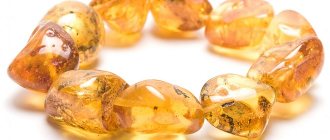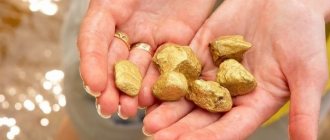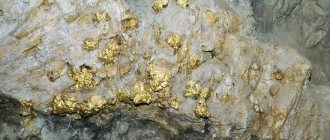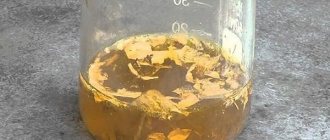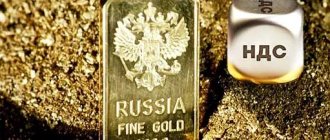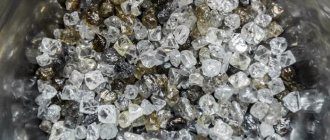- September 17, 2019
- Directions
- Victoria Samarskaya
This article will be useful to those who are interested in where gold is mined in Russia: cities, deposits, enterprises. Our country is among the top three in mining the yellow metal, second only to China and Australia. Most of the mines are geographically located in the southern and central regions of our country.
Major gold mining companies
We list the largest ones that provide industrial production of the yellow metal:
- PJSC Polyus, spun off from OJSC Norilsk Nickel in 2006. The main owners are Suleiman Kerimov (37% of shares) and his family. This is one of the world's largest enterprises engaged in gold mining in the Irkutsk, Krasnoyarsk, Magadan and Amur regions. Based on the geography of the company's mines, you can understand where gold can be found in Russia.
- Kinross Gold is an international company headquartered in Toronto. On the territory of the Russian Federation, it is developing the Kupol field in Chukotka (Anadyr region).
- JSC "UGK" is a group engaged in gold mining both open and closed methods in the Krasnoyarsk Territory, Chelyabinsk Region and the Republic of Khakassia.
- PJSC Severstal, which separated gold mining assets into an independent enterprise Nordgold, which has international status. Owns five mines in the Russian Federation (Amur Region, Buryatia, Republic of Sakha).
- JSC Polymetal, which ranks second in Russia in terms of gold production. Its deposits are located in the Urals, Chukotka, and Magadan region.
- PJSC "Vysochaishy" It was created to develop the Golets Vysochaishy mine (Irkutsk region), but also mines the yellow metal in the Republic of Sakha.
About the extraction of yellow metal by private owners
You can often hear the question of where private owners mine gold in Russia. Many experienced a period when any person, practically without any official permission, could engage in mining and washing yellow sand. This is the 90s: from 1992 to 1998. Today, illegal mining is subject to a large fine and confiscation of equipment. There is also criminal liability for storing reserves worth more than 1 million rubles. Despite the ban, up to 10% of production comes from illegal gold miners.
But from 2021, individuals have the opportunity to obtain a license to develop small plots (150 thousand sq. m). To do this, you need to register an individual entrepreneur. Private owners have many restrictions: the license period is 5 years, miners do not have the right to use hired labor and heavy equipment. Extraction is carried out exclusively by hand. The Rosnedra agency has a register of vacant sites, but official registration of prospectors is proceeding slowly. The point is taxation (on profit and production), as well as the need to carry out exploration ourselves and take care of safety.
Algorithm for obtaining a license
To become the owner of the coveted gold mining license, you must complete the following points:
- select the plot of land you are interested in at an auction held on the Rosnedra website. The site may also be offered during the competition;
- fill out an auction (competition) participant form;
- provide the event organizers, upon their request, with all necessary documents;
- win the event;
- get the desired license.
Where is gold mining done?
If a person is puzzled by the question of where to mine gold in Russia himself, then he should contact the Rosnedra agency for the allocation of a free plot. The most promising ones are those where existing mines were previously located. Thus, in the Amur region, a deposit in which gold mining has been carried out since the 19th century has been closed. Surely there is something to profit from there today.
Areas that are currently being developed industrially using heavy equipment are also considered promising. Private owners have the opportunity to enter into agreements with large companies, which, for a certain percentage, allow mining of the yellow metal in territories that are inconvenient for them. Such large testing grounds are located in Yakutia and the Urals. Dense soils are considered the most promising, which is why most prospectors are in the east of the country and in the taiga. Where in Russia are deposits of precious metals located?
Where does gold come from?
Metals with an atomic mass of more than 55 units (heavier than iron), which cannot be formed inside stars, arise as a result of gamma-ray bursts - releases of energy in space during supernova explosions. Gold came to Earth with asteroids many years ago, when our planet was just being formed and had no atmosphere. Most of the heavy elements sank below the Earth's surface and formed the core.
There are few precious metals on the surface. Their main volume is located in the mantle - the substance between the earth's crust and core. In the upper layers of the mantle, a hot melt is formed - magma, which in some places penetrates the surface of the Earth. There it hardens and turns into solid rock, containing almost the entire periodic table.
Magma is heterogeneous, hardens unevenly - refractory substances coexist with low-melting substances, and the latter continue to circulate inside the solidified former. This is how gold veins are formed within the rock.
Geography of gold mining
On the map just above you can see that most of the gold deposits are located in the Urals and beyond the Urals. In the central part there are only three gold mining provinces. We are talking about the Karelo-Kola, Caucasian and Dnieper-Don zones. The main reserves of the yellow metal are represented in the Asian territory of the Russian Federation. When asked where gold is mined in Russia, any representative of this industry will name Chukotka, Amur, Magadan, Bodaibo, Taximoto and the Urals. By the way, one of the largest nuggets was found in Bilibino (Chukotka). His weight was 16 kg. Let us list the most famous deposits where work is being carried out today.
Magadan Region
This region is the leader in alluvial gold mining, although there are also ore deposits here. The development of deposits began in the region only in the 30s. XX century, and today there are already more than 547 deposits in Kolyma. They produce 14-17 tons of placer gold per year. We list the largest deposits:
- “Natalkinskoe” (Tenkinsky district, Omchak river). Discovered in 1942, it provides 79% of all gold reserves in the region.
- “Pavlik” (Tenkinsky district, near the village named after Gastello). Discovered in 1942, it provides 7.3% of the yellow metal reserves.
- "Perekatnoe" (North-Evensky district). Discovered in 1961 (5.7% of gold reserves).
If we are interested in where prospectors mine gold in Russia, then we should know: it is in this region that about 12 small deposits are listed in the undistributed fund. Their reserves are estimated at 356 tons. Therefore, private owners most often flock to Kolyma for success.
Chukotka
The autonomous region has taken 2nd place in the Russian Federation in gold mining. In total, approximately 25 tons of yellow metal are mined here every year. Mostly ore. The largest deposits are:
- “Dome” (border of Bilibinsky and Anadyr districts). Opened in 1991. Mining is carried out using both open-pit and open-pit mining methods. The depth of the quarry is 90 m. Its reserves are estimated at 65.5 tons.
- "Double" (Bilibinsky district). Opened in 1983. Reserves are estimated at 37 tons.
Both deposits are gold-silver. The region has many inaccessible places, so there are a large number of black miners active here. This is about the question of where gold can be mined in Russia.
Changes in laws. Gold mining for individual entrepreneurs and individuals
From the moment when amendments were made to the legislative framework, private individuals were allowed to mine gold only in those regions where industrial mining is not carried out. We are also talking about the extraction of valuable minerals, diamonds, and other treasures. The Law on Precious Metals and Minerals does not provide for the right of such mining to private individuals who have the status of individual entrepreneurs without registering a legal entity, but only to enterprises.
Gold mining by private owners can be carried out in volumes that are not comparable to industrial ones. In other words, an individual entrepreneur can mine host rocks, dumps, waste from mining corporations, substandard ore, written-off reserves, deposits of ores and gold sands of loose or bedrock type.
Federal laws regarding precious metals and stones should regulate unreported and untaxed gold mining. However, the voices of will, which are private traders, can hardly compete with large firms. Individual entrepreneurs can work in areas where large-scale mining has already been established or the availability of gold is in question.
Gold mining by individual entrepreneurs in registered areas, from some point of view, makes sense. The amount of metal in them is relatively small. Using industrial capacity to extract 10 grams of ore is, at a minimum, not profitable. But individuals should have quick access to subsoil, benefits and discounts when calculating taxes and fees.
Interesting: We buy silver bars at Sberbank - nuances and prices
Metal mining is different from product manufacturing or marketing. Even if all the conditions are met, there may simply be no metal in the ground. On this side, mining is a very risky business.
Why were private owners allowed to mine?
In the Magadan region, one of the richest in gold minerals, there are many abandoned or exhausted sources. If private owners are allowed to mine in these areas, problems with the creation of new jobs in the region can be resolved.
According to statistics from the administration of the Magadan region, approximately 1,500 citizens are employed in the gold mining industry and have ever had such experience. Gold deposits are approximately 900 kg. It is not very profitable for large ones - in rich regions such a catch can be obtained in a month.
Saha Republic
20% of the republic’s total wealth is gold deposits. There are more than 800 mines here, including many small ones along the Bolshaya Kuranakh River. A gold rush swept the republic in the middle of the 19th century, after the indigenous residents began to give huge bullion to Russian merchants for next to nothing, without even suspecting their real value. More than half of the production is placer gold. Among the most famous deposits are:
- “Side”, “New” and “South”. They stretch for 10 km along Big Kuranakh. Layered deposits are developed here (western zone).
- “Severnoye”, “Yakutskoye”, “Delbe”, “Gagarskoye”, “Kanavnoye”, “Dorozhnoe”, “Korotkoye”, “Porfirovoe” (eastern zone). The total length of these deposits along the river is 25 km.
So, where is gold mined in Russia? Yakutia provides about 25 tons per year.
Classification of gold deposits
There are two types of deposits. They are divided into:
- primary, they are also radical;
- secondary - alluvial.
Indigenous
Primary deposits are the same fragments of magma ejected onto the surface of the globe. It happens that gold is present in the rock in the form of veins and nuggets, but more often it is alloyed with other elements: gold ores with copper, quartz, iron and sulfur compounds, and polymetallic alloys are common.
The main deposits of gold mined in Russia are concentrated in primary deposits.
Alluvial
Secondary deposits appeared as a result of destruction (weathering) of primary ones. Weathering refers to the impact not only of air currents, but also of water, temperature changes and even the activity of bacteria. It was alluvial deposits that were so diligently developed by amateur, lone miners.
Until the end of the 19th century, gold was mined mainly from placers - by washing (sliding), which is possible due to the relative gravity of gold. Lighter impurities were washed away with water, leaving gold sand in the washing trays, which was melted into ingots and products.
At the end of the 19th century - during the era of the birth of the scientific and technological revolution - technologies appeared that made it possible to effectively develop igneous rock. This has affected the scale of gold mining: it is believed that 60% of all gold mined in the entire history of mankind is metal produced over the past 150 years.
Irkutsk region
We name the region that ranks 4th in gold mining. It supplies the country with 23 tons of yellow metal per year. The main deposits provide the production of alluvial gold, 95% of which is located in the Bodaibinsky district. We list the main ones:
- "Sukhoi Log" (137 km from Bodaibo). The deposit was discovered in 1961 and today provides 28% of the country’s total gold reserves. Subsoil resources are estimated at 2700 tons.
- "Zapadnoye", located 1.5 km from Sukhoi Log.
- "Verninskoye" (125 km from Bodaibo and 15 km from the Sukhoi Log deposit).
- “Golets Vysochaishy” (175 km from Bodaibo). Mining is carried out in open pits.
- “Devil's Koryto” (185 km north of Bodaibo). Discovered in 1962, it belongs to the shale type.
Document requirements
In addition to paying for the mining permit, the applicant will also need to present a copy of his passport, an application for registration in accordance with the established form and a receipt for payment of the state duty.
By the way, the result of your request for permission can sometimes come only a month after completing all the necessary actions. So, you'll have to wait a little.
Amur region
The Amur region competes with the Irkutsk region. The extraction of yellow metal is carried out both in mines and in placers. Numerous prospectors flock here. Here's where you can mine gold in Russia:
- “Berezitovoye” deposit (Tyndinsky district, Khaikta river). 2 thousand tons of gold are mined here annually using the open-pit method. Nordgold plans to move to underground work, which has not been carried out in the region since 1994.
- "Pioneer" (Magdagachinsky district) was put into operation in 2008.
Khabarovsk region
In 2021, the region extracted more than 23 tons of the yellow metal, becoming one of the leaders in the development of valuable minerals. We list the most famous deposits where gold is mined in Russia:
- "Khakadzhinskoe" (Okhotsk-Chukotka volcanic belt).
- "Yuryevskoe".
- "Avlayakan."
- "Ozernoye"
All of them are ore, because placer gold makes up only the 4th part of the region’s total production.
Diamond producing countries
Since each diamond is unique in its kind, it is customary to separate their accounting among world countries according to production volumes and in value terms. The bulk of diamond production is distributed among only nine countries. These are Russia, the Republic of Congo, Botswana, Australia, Canada, Angola, South Africa, Zimbabwe and Namibia.
In value terms, the leaders among these countries are Russia, African Botswana and Canada. Their total diamond production accounts for more than 60% of the value of the world's mined diamonds.
For incomplete 2021 (according to the latest data), Russia takes first place in terms of production volumes and value. Its share in value terms accounts for about 40% of total world production. This leadership has belonged to Russia for several years.
Transbaikal region
This region attracted prospectors and adventurers back in the 17th century, but the search for ore was not crowned with success. The desired gold was discovered only in the middle of the 19th century. Today, more than a thousand deposits have been discovered in the region, about 13 tons of yellow metal are mined per year. The region should be considered promising, since alluvial gold, which is low-cost, is predominantly widespread here. The largest deposits:
- "Novo-Shirokinskoye" (Gazimuro-Zavodsky district). It is located in the Shirokino fault zone.
- "Alexandrovskoe" (Mogochinsky district).
- "Kirchenovskoe" (Olovyanninsky district).
- "Savkinskoye" (Nerchinsko-Zavodsky district).
Extraction Methods
As mentioned above, aurum is often fused with other chemical elements in the depths of the earth. Therefore, it must be separated by selecting pure gold. Specialized technology, as well as advances in the chemical industry, have achieved considerable success in this. Moreover, the process of separating particles of “yellow metal” has become almost automated.
Among the main selection methods are known:
- almagalming;
- sodium cyanide leaching;
- flotation.
Despite the complicated name of the first method, if you know the basics of chemistry, you can definitely do the same steps. The essence of almagalming is the use of ordinary mercury. After all, she can attract gold. The course of action takes place in several steps:
- Mercury and rocks are placed in the tank, after which they are shaken.
- Mercury attracts gold and settles at the bottom of a special container.
- The container is heated and the precious metal is separated from the mercury.
This method was quite common due to its practicality and low cost. But today it is not recommended to use it, since mercury has a detrimental effect on the human body.
Leaching with sodium cyanide is an equally popular method. To begin with, the previously mined rock is ground to the smallest particles. Then add sodium cyanide and shake the container well. Unnecessary liquid is released, and solid particles of rock settle to the bottom.
Flotation is not much different from leaching. The rock is also crushed, and then filled with water and oil, after which it is mixed. The liquid remains on the surface, and the metal settles at the bottom.
Sverdlovsk region
From 6 to 11 tons of gold are supplied annually from this region of the Urals. The first gold nugget was found here back in the 18th century, so the Sverdlovsk region is considered the key with the help of which the main deposits of the Far East and Siberia were subsequently discovered. The most famous in the Sverdlovsk region is “Kochkarskoe”, because it has been developed since 1799.
